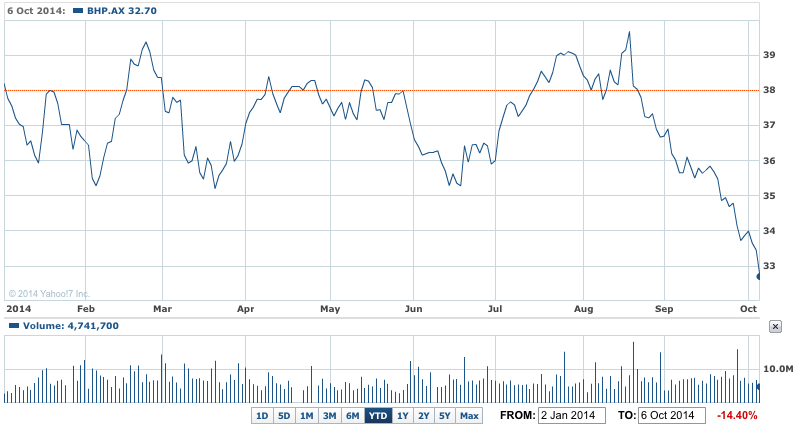A definite thumbs down from nervy investors to news yesterday from BHP Billiton (BHP) that it plans to dramatically expand its Western Australian iron ore operations.
BHP’s news hurt other iron ore miners and the wider market, which fell more than 20 points.
BHP shares dropped 2.2% to a 2014 low of $32.70, after hitting a 52 week low of $32.68 during trading. Rio Tinto (RIO) shares were down 2.1% at $57.59, while third-ranked iron ore producer Fortescue Metals Group (FMG) slumped 4.3% to to $3.30.
The sell-down in BHP helped drag the overall market down 22 points.
Investors were surprised to hear and read that at a time of rising global oversupply, BHP has plans to cut costs (good news) and boost output (worrying).
BHP told a tour of analysts, and then the wider market, that it wants to overtake Rio Tinto as the world’s biggest exporter by boosting shipments from the 225 million tonnes in 2014, to 290 million tonnes by 2017.
BHP believes it can produce iron ore, before the cost of shipping and government royalties, for less than $US20 per tonne. (The price was $US25.89 a tonne in 2013-14, down from more than $US29 a tonne a three years ago, according to the company’s annual report).
BHP estimates it can get a 25% reduction compared to 2013-14, and the company believes it will require a lower level of sustaining capex over the next few years of growth than its rivals will.
BHP YTD – BHP sees iron ore costs of $US20 a tonne

“We aim to be the lowest cost supplier to China on an all-in cash basis," the company said in a statement yesterday.
“The economics of further increasing our production are compelling."
The head of BHP’s iron ore business, Jimmy Wilson said in the statement.
“We continue to see healthy demand growth for iron ore in the mid-term as Chinese steel production is expected to increase by approximately 25 per cent to between 1.0 and 1.1 billion tonnes in the early to mid-2020s,” he said.
“Meanwhile, steel production growth in other emerging economies is outpacing China as those nations urbanise and industrialise. We expect to see a compound annual growth rate for global steel production of between 2.5 and 3.0 per cent between now and 2030.
“Unsurprisingly, high prices over the last decade created the incentives needed for new entrants to join the market and traditional producers to substantially increase supply. As a result, growth in seaborne supply is expected to exceed growth in demand over the short to medium term.
“In anticipation of this transition, we turned our focus from major supply chain investment to productivity, cost reduction and capital efficient growth more than two years ago.”
“We have the strongest resource position in Western Australia and the quality of our ore bodies will help us sustain strong margins over the long term. We have already significantly cut the cost of production at WAIO and plan to go further,” he said.
“We expect unit cash costs of less than US$20 per tonne in the medium term, a reduction of more than 25 per cent on the average achieved in the 2014 financial year.
“Our reserves are concentrated around our four major mining hubs which will support a lower level of sustaining capital expenditure than required by our peers. With annual sustaining capex of approximately US$5 per tonne over the next five years, we aim to be the lowest cost supplier to China on an all-in cash basis.”
Mr Wilson also said BHP Billiton could add 65 million tonnes of capacity at WAIO at a capital intensity of approximately US$30 per annual tonne, taking total system capacity from 225 Mtpa to 290 Mtpa by the end of the 2017 financial year.
“The economics of further increasing our production are compelling. We completed our major supply chain investments some time ago and have since focussed on using BHP Billiton’s benchmarking systems to improve the performance of our equipment by systematically tackling the bottlenecks,” he said.
“We now expect to increase WAIO mine capacity to 275 Mtpa without the need for additional fixed plant investment. Beyond that, the Inner Harbour Debottlenecking and Jimblebar Phase 2 projects3 will help us to reach 290 Mtpa of supply chain capacity at low capital cost.”
Now he and the rest of the company will have to convince nervous investors that these plans will not see BHP cut its own throat by flooding an already oversupplied market with ore that can only be sold at ever falling prices – regardless of the cost cuts or the value of the Australian dollar.













